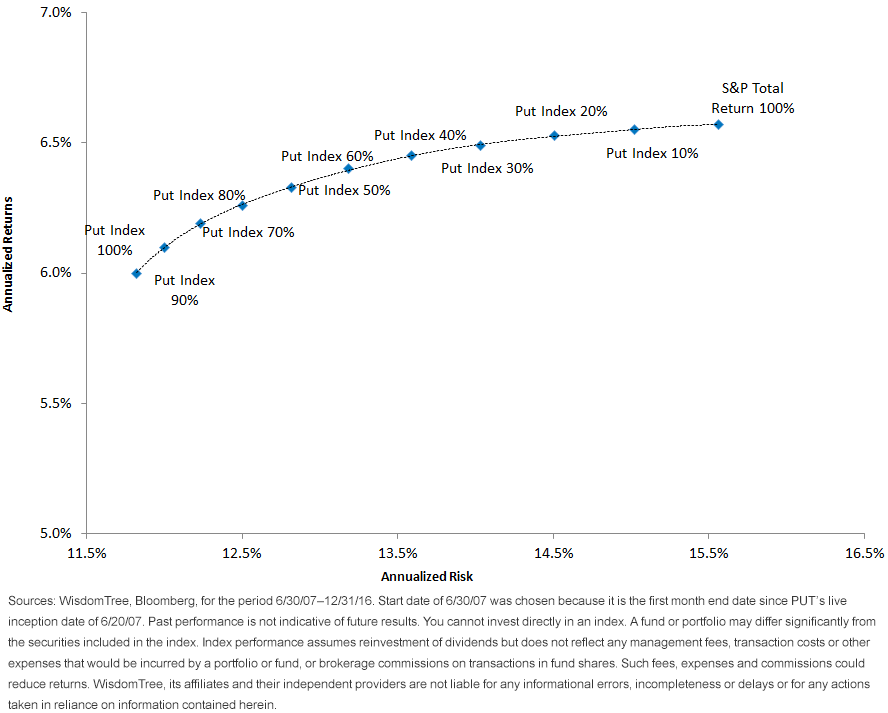What to Do at Market Highs


With U.S. markets up over 300% since the March 2009 lows and continuing to set new all-time highs, where are investors to look for future returns?1 Although U.S. valuations are stretched compared to developed international (specifically Japan) and emerging markets, we think the pro-growth policies and potential tax cuts put forward by the new administration can help drive earnings growth for U.S. companies, which in our opinion would help the market rally continue.
With investing, nothing can be certain, and because valuation risks are elevated in the U.S., we think it is prudent to incorporate a risk-managed approach such as an option strategy, which can help mitigate risk. Also, when investors perceive upside potential may be constrained as a result of past gains and high current valuations, options writing strategies that generate returns from premiums might make sense, even though the upside is capped.
The WisdomTree CBOE S&P 500 PutWrite Strategy Fund (PUTW)
The WisdomTree CBOE S&P 500 PutWrite Strategy Fund (PUTW) seeks investment results that, before fees and expenses, generally correspond to the performance of the CBOE S&P 500 PutWrite Index (PUT). PUTW invests in one- and three-month Treasury Bills and sells or “writes” S&P 500 Index put options. The Fund writes European-style options, and the number of put options sold is chosen to ensure full collateralization. Also, the options are written “at the money,” or at the current level of the S&P 500 Index, on a monthly basis.
The option premiums the Fund receives from selling puts can help mitigate the negative effects of investing only in investment vehicles that track the S&P 500 Index. Historically, PUT, the index PUTW is designed to track, had returns similar to the S&P 500 Index but with less risk, so blending the two could offer attractive risk-adjusted returns.
- PUT provided approximately 90% of the return of the S&P 500 but had a beta that was two-thirds that of the S&P 500 Index.
- Blending incremental amounts of PUT with the S&P 500 consistently lowered the risk while maintaining comparable levels of returns of the S&P 500.
- Blending a 30% allocation to PUT was able to generate a return that was over 98% of the S&P 500 but with 10% less risk.2
Blending PUT with the S&P 500 Index

What if Volatility Increases?
At current valuations, we believe a wise move for investors could be to incorporate potential “shock absorbers” in portfolios such as PUTW, which can provide a cushion to portfolio drawdowns during periods of equity corrections.
The amount of premiums the Fund receives is tied to the implied volatility of the S&P 500, or how volatile investors perceive the S&P 500 to be. The higher the implied volatility, the higher the premiums the Fund will receive; conversely, the lower the implied volatility, the lower the premiums. Obviously, higher volatility and higher premiums don’t equate to higher returns; however, the higher the premium, the higher the potential cushion for a negative market move.
The most important relationship to watch is the one between implied and realized volatility. Historically, implied volatility was often higher than realized volatility, and if this relationship continues to hold, we believe the Fund may continue to profit by receiving more in premiums.
1Sources: WisdomTree, Bloomberg, for the period 3/9/09–2/28/17. U.S. market refers to the S&P 500 Index.
2Sources: WisdomTree, Bloomberg, for the period 6/30/07–12/31/16. Sources apply to all bullets.
Important Risks Related to this Article
There are risks associated with investing, including possible loss of principal. The Fund will invest in derivatives, including S&P 500 Index put options (“SPX Puts”). Derivative investments can be volatile, and these investments may be less liquid than securities, and more sensitive to the effects of varied economic conditions. The value of the SPX Puts in which the Fund invests is partly based on the volatility used by market participants to price such options (i.e., implied volatility). The options values are partly based on the volatility used by dealers to price such options, so increases in the implied volatility of such options will cause the value of such options to increase, which will result in a corresponding increase in the liabilities of the Fund and a decrease in the Fund’s NAV. Options may be subject to volatile swings in price influenced by changes in the value of the underlying instrument. The potential return to the Fund is limited to the amount of option premiums it receives; however, the Fund can potentially lose up to the entire strike price of each option it sells. Due to the investment strategy of the Fund, it may make higher capital gain distributions than other ETFs. Please read the Fund’s prospectus for specific details regarding the Fund’s risk profile.
Neither WisdomTree Investments, Inc., nor its affiliates, nor Foreside Fund Services, LLC, or its affiliates provide tax advice. All references to tax matters or information provided in this material are for illustrative purposes only and should not be considered tax advice and cannot be used for the purpose of avoiding tax penalties. Investors seeking tax advice should consult an independent tax advisor.


